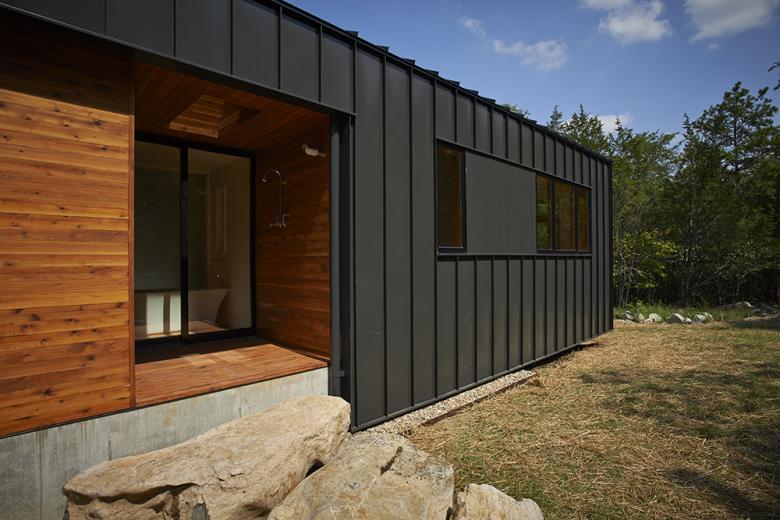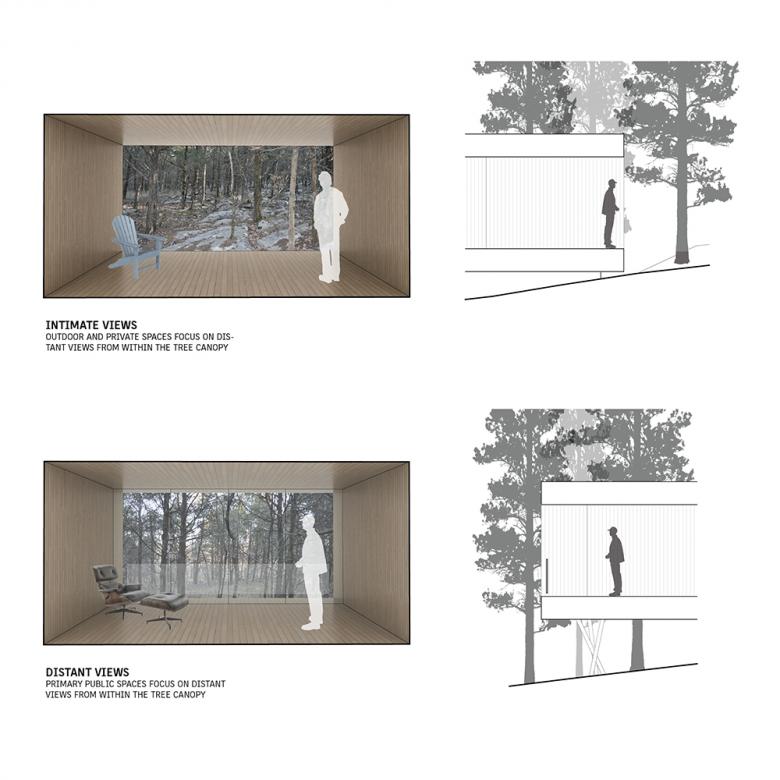Holston River House
Holston River House
21. October 2013
Tennessee is a state with diverse natural features as—from west to east—fertile plantations give way to rolling hills and then the rugged landscape of the Appalachian Mountains. Sanders Pace Architecture designed a house within the latter for a young couple's first home. The architects used the rocky and wooded terrain to their advantage, developing a Y-shaped plan that responds the former while strategically framing views of the. Architect Brandon Pace answered a few questions about the house just completed this fall.
Approach from below
What were the circumstances of receiving the commission for this project?
A young couple approached us in late 2011 asking if we would help evaluate the feasibility of building their first home together on a rural East Tennessee site. The rocky, heavily wooded terrain presented quite a challenge but after reviewing county regulations and covenants tied to the site we established goals for the project and commenced design work.
View through dining toward rock outcropping
Can you describe your design process for the building?
The primary site constraints were clearly visible in the form of moss covered rock outcroppings scattered throughout the wooded hillside. Initial conceptual design efforts focused on options, which limited the impact on the site while taking advantage of the unique opportunities presented by this rugged landscape. Early schemes were narrow and linear, weaving around the rock outcroppings and following the site’s contours in an effort to limit the elevation change from front to back. This siting also allowed for a series of framed views connecting the house to both the immediate landscape (rock outcroppings) and distant landscape (the Holston River and the mountains).
As the design developed pier footing options were explored which allowed portions of the building to be elevated above the landscape to limit the site impact and take advantage of the natural slope of the site. In order to maximize the access to views from the building’s three main zones the public space was dislocated from the primary linear form and extended out over the landscape on piers, which allowed rock outcroppings below to remain intact while placing the public space within the tree canopy oriented towards distant views to the river and mountains beyond.
South elevation at outdoor shower
How does the completed building compare to the project as designed? Were there any dramatic changes between the two and/or lessons learned during construction?
The completed building does not differ from the designed version in its form or overall design intent. The biggest changes from design to construction dealt with material specification changes, which resulted from our goal to keep the project within a modest budget. These changes included the use of standard residential concrete formwork in lieu of board formed concrete and a switch from standing seam anthracite zinc panels to a more conventional painted metal standing seam panel. These changes were not unanticipated; we’ve learned from other projects that an exploration of the ideal material alongside those acceptable alternatives is an important part of the design process and not something that should be left to the sometimes-unpredictable value engineering process that often precedes construction.
Kitchen
How does the building compare to other projects in your office, be it the same or other building types?
Within our office the design process is structured in a similar way regardless of project type or scale. We begin by trying to identify the variables and constraints unique to the given project. Design options and iterations explored during the design process are specific to these variables, the built work being a product of this process. While our projects share a process and an overall commitment to efficiency of space and form, the solutions are typically quite different. The Holston River House is unique to these clients in its spatial distribution, its orientation reflective of the views generated from the primary zones, its gabled metal clad form a nod to nearby vernacular structures, its concrete and cedar skin appropriate to the building’s siting within a rocky cedar forest.
View through outdoor terrace toward dining
How would you describe the architecture of Tennessee and how does the building relate to it?
At 500 miles from tip to tip Tennessee is one of the longest states and the architecture is somewhat reflective of the landscape and history of the state’s primary regions. Moving from the early structures of the rugged frontier territory of East Tennessee through the antebellum homes sited within the rolling hills of Middle Tennessee to the fertile plantations of West Tennessee, the architecture of the state is diverse. Home to Graceland and the world’s only full-scale replica of the Parthenon, the state lacks a consistent architectural identity.
Sited in a valley between the Cumberland Mountains and the Great Smoky Mountains, the immediate context of the Holston River House consists primarily of an eclectic mix of small gable roof structures, pre-manufactured mobile homes, and the houses of an early 20th century company town centered around a local zinc mine. While the narrow gable form is evocative of the modest, unpretentious forms of some of these nearby buildings, the expansive glazing and framed views come from a more specific desire to integrate building and landscape. While there may be no consistent stylistic vision that describes the architecture of Tennessee, the notion of achieving a site and culturally specific architecture from region to region and site to site is one that continues to inform the architecture of the state.
Email interview conducted by John Hill.
Site Plan
Site Photo + Floor Plan
View Diagrams
Holston River House
2013
Mascot, Tennessee
Client
Laura Sohn and Carlos Anderson
Architect
Sanders Pace Architecture
Knoxville, TN
Design Principal
Brandon F. Pace, AIA
Project Team
Michael A. Davis
Daniel Jones
Structural Engineer
Chad Stewart & Associates
MEP/FP Engineer
Griffith Engineering
Contractor
Grace Construction
Construction Manager
Scott Branscom
Exterior Metal Roof & Siding
Pac-Clad
Windows & Doors
Eagle
Exterior Wood Siding
Cedar w/Sikkens finish
Casework
Fork Design
Site Area
19 acres
Building Area
2,546 sf (conditioned), 3,470 sf (total under roof)
Drawings
Sanders Pace Architecture







